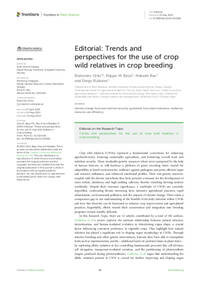Editorial: Trends and perspectives for the use of crop wild relatives in crop breeding

Authors:
Crop wild relatives (CWRs) represent a fundamental cornerstone for enhancing agrobiodiversity, fostering sustainable agriculture, and bolstering overall food and nutrition security. These invaluable genetic resources where never pampered by the help of human farmers, so still harbour a plethora of genes encoding traits crucial for adaptability to harsh environments, resilience against pathogens and pests, efficient input and resource utilization, and enhanced nutritional profiles. Their vast genetic reservoir, coupled with the diverse microbiota they host, presents a treasure for the development of more robust, nutritious, and high-yielding cultivars, thereby enriching farming systems worldwide. Despite their immense significance, a multitude of CWRs are currently imperilled, confronting threats stemming from intensive agricultural practices, rapid urbanization, environmental pollution, and the impacts of climate change. There exists a conspicuous gap in our understanding of the breadth of diversity inherent within CWRs and how this diversity can be harnessed to enhance crop improvement and agricultural practices. Regrettably, efforts toward their conservation and integration into breeding programs remain notably deficient.
